
According to Abrahamic religions, Aaron was a prophet, a high priest, and the elder brother of Moses. Information about Aaron comes exclusively from religious texts, such as the Hebrew Bible, the New Testament, and the Quran.

The Ark of the Covenant, also known as the Ark of the Testimony or the Ark of God, is believed to have been the most sacred religious relic of the Israelites. It is described as a wooden chest coated in pure gold and topped off by an elaborate golden lid known as the mercy seat. According to the Book of Exodus and First Book of Kings in the Hebrew Bible and the Old Testament, the Ark contained the Tablets of the Law, by which God delivered the Ten Commandments to Moses at Mount Sinai. According to the Book of Exodus, the Book of Numbers, and the Epistle to the Hebrews in the New Testament, it also contained Aaron's rod and a pot of manna.

Abiathar, in the Hebrew Bible, is a son of Ahimelech or Ahijah, High Priest at Nob, the fourth in descent from Eli and the last of Eli's House to be a High Priest.

The Book of Samuel is a book in the Hebrew Bible, found as two books in the Old Testament. The book is part of the Deuteronomistic history, a series of books that constitute a theological history of the Israelites and that aim to explain God's law for Israel under the guidance of the prophets.
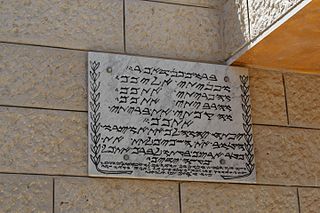
Samaritanism is an Abrahamic, monotheistic, and ethnic religion. It comprises the collective spiritual, cultural, and legal traditions of the Samaritan people, who originate from the Hebrews and Israelites and began to emerge as a relatively distinct group after the Kingdom of Israel was conquered by the Neo-Assyrian Empire during the Iron Age. Central to the faith is the Samaritan Pentateuch, which Samaritans believe is the original and unchanged version of the Torah.
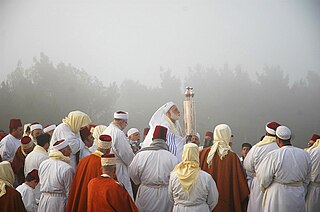
The Samaritans, also known as Israelite Samaritans, are an ethnoreligious group originating from the Hebrews and Israelites of the ancient Near East. They are indigenous to Samaria, a historical region of ancient Israel and Judah that comprises the northern half of today's West Bank. They are adherents of Samaritanism, an Abrahamic, monotheistic, and ethnic religion that developed alongside Judaism.
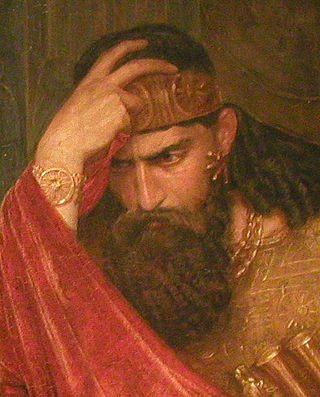
Saul was a Jewish monarch of ancient Israel and the first king of the United Kingdom of Israel, according to the Hebrew Bible and Old Testament. His reign, traditionally placed in the late 11th century BC, supposedly marked the transition of Israel and Judah from a scattered tribal society ruled by various judges to organized statehood.

Samuel is a figure who, in the narratives of the Hebrew Bible, plays a key role in the transition from the biblical judges to the United Kingdom of Israel under Saul, and again in the monarchy's transition from Saul to David. He is venerated as a prophet in Judaism, Christianity, and Islam. In addition to his role in the Bible, Samuel is mentioned in Jewish rabbinical literature, in the Christian New Testament, and in the second chapter of the Quran. He is also treated in the fifth through seventh books of Antiquities of the Jews, written by the Jewish scholar Josephus in the first century. He is first called "the Seer" in 1 Samuel 9:9.

The Samaritan Pentateuch, also called the Samaritan Torah, is the sacred scripture of the Samaritans. Written in the Samaritan script, it dates back to one of the ancient versions of the Torah that existed during the Second Temple period, and constitutes the entire biblical canon in Samaritanism.

Shechem, also spelled Sichem was an ancient city in the southern Levant. Mentioned as a Canaanite city in the Amarna Letters, it later appears in the Hebrew Bible as the first capital of the Kingdom of Israel following the split of the United Monarchy. According to Joshua 21:20–21, it was located in the tribal territorial allotment of the tribe of Ephraim. Shechem declined after the fall of the northern Kingdom of Israel. The city later regained its importance as a prominent Samaritan center during the Hellenistic period.
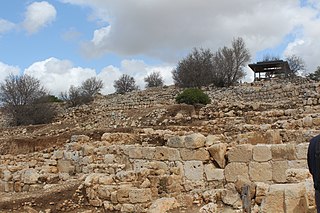
Shiloh was an ancient city and sanctuary in ancient Israel located in the region of Samaria. According to the Hebrew Bible, Shiloh was one of the main centers of Israelite worship during the pre-monarchic period, before the First Temple in Jerusalem was built. After the Israelite conquest of Canaan, the Tabernacle was moved to Shiloh, and remained there during the period of the biblical judges.

Mount Gerizim is one of two mountains in the immediate vicinity of the Palestinian city of Nablus and the biblical city of Shechem. It forms the southern side of the valley in which Nablus is situated, the northern side being formed by Mount Ebal. The mountain is one of the highest peaks in the West Bank and rises to 881 m (2,890 ft) above sea level, 70 m (230 ft) lower than Mount Ebal. The mountain is particularly steep on the northern side, is sparsely covered at the top with shrubbery, and lower down there is a spring with a high yield of fresh water. For the Samaritan people, most of whom live around it, Mount Gerizim is considered the holiest place on Earth.
Baba II Rabba, was a notable Samaritan High Priest. He is believed to have lived during the late third and early fourth centuries CE; Jeffrey Cohen puts his birth at 288 and his death at 328.
Zadok, also spelled Ṣadok, Ṣadoc, Zadoq, Tzadok or Tsadoq, was a Kohen (priest), biblically recorded to be a descendant from Eleazar the son of Aaron. He was the High Priest of Israel during the reigns of David and Solomon. He aided King David during the revolt of his son Absalom, was subsequently instrumental in bringing Solomon to the throne and officiated at Solomon's coronation. After Solomon's building of the First Temple in Jerusalem, Zadok was the first High Priest to serve there.
In the Torah, Ithamar was the fourth son of Aaron the High Priest. Following the construction of the Tabernacle, he was responsible for recording an inventory to ensure that the constructed Tabernacle and its contents conformed to the vision given by God to Moses on Mount Sinai.
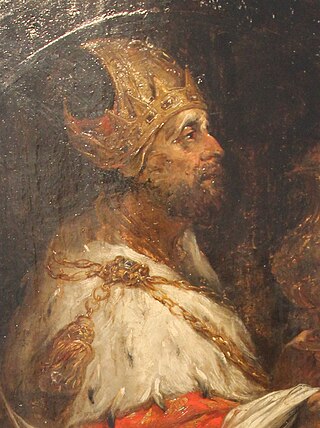
In the Bible, Melchizedek, also transliterated Melchisedech or Malki Tzedek, was the king of Salem and priest of El Elyon. He is first mentioned in Genesis 14:18–20, where he brings out bread and wine and then blesses Abram and El Elyon.
Sanballat the Horonite – or Sanballat I – was a Samaritan leader, official of the Achaemenid Empire, and contemporary of the Israelite prophet Nehemiah who lived in the mid-to-late 5th century BC. He and his family are mentioned in the contemporary Elephantine papyri and ostraca.
The Book of Joshua, sometimes called the Samaritan Chronicle, is a Samaritan chronicle so called because the greater part of it is devoted to the history of Joshua. It is extant in two divergent recensions, one in Samaritan Hebrew and the other in Arabic.















